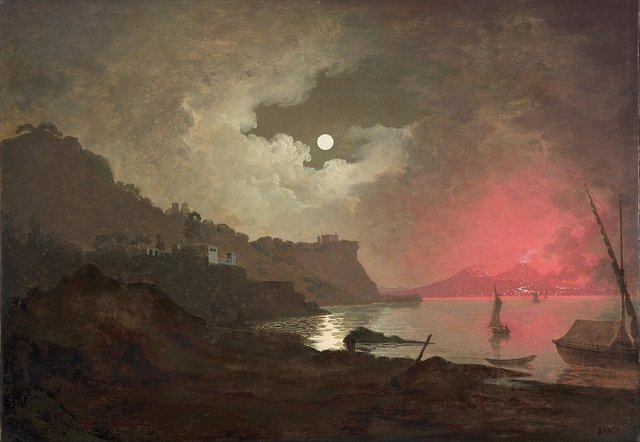[ART HISTORY] The Allure of Volcanoes
As a child, I had great enthusiasm for volcanoes. I enjoyed drawing the conical silhouettes in my sketchbook, and fantasized about crater lakes where amphibious air craft could land. I was also attracted to the combination of snow-covered mountain peaks and glowing lava. A sort of tantalizing worry hovers over the negligible smoke signal that slowly seeps out of the crater - an elusive slumber that can suddenly turn into a devouring wrath and transform the sky into an inferno of fire and smoke. Forests and plains would be buried under the dust and liquid magma - tree would catch fire, bodies of water would sizzle. Like pewter being poured into molds, the homes of people would be filled with and wrapped in stone. Beauty and violence, disaster and creation.

Joseph Wright of Derby, a painter of the Enlightenment era, was a man with a particular feel for volcanoes. He's perhaps best known for his images of technology and science, but he also painted a large amount of landscapes and portraits. During an extended stay in Italy in the 1770s Wright witnessed an eruption of Mount Vesuvius, which became the motive for a long series of paintings through his artistry.
The philosopher Edmund Burke was one of those who in the 1700s built on the ancient ideas about "the sublime". Burke argued that the sublime can be discerned when the beauty exceeds the dimensions and constraints of human perception. The sublime broadens and opens up beauty towards the dark side, towards vulnerability and horror. When beauty is painted in bright pastels and soft shapes, the sublime experience is dark, unyielding and rich in contrast. In the horror mixed with delight, the sublime can make man feel alive; in storms, fires, canyons and mountains, she can experience the majesty of the Creation.


This emerges with great force in Wright's volcanic eruptions. He stands on the other side of the bay, watching how the people flee for their lives. The meeting between intense light and deep darkness provides refined chiaroscuro effects, which is further complicated by the pale moonlight. With his brush, the artist follows the indomitable magma down the slopes and hollows, and its cinnabar red glows in the night. Perhaps he sees an equivalent to the lava in his colors, a kind of stratigraphy in paint: layer upon layer it's applied on the canvas to then solidify - a new layer of oil, pigments, memories.
— SteemSwede (art historian, forensic psychologist & painter.)
The paintings by Joseph Wright of Derby in their order:
1. Vesuvius in Eruption, with a View over the Islands in the Bay of Naples, c. 1776–80
2. Vesuvius from Portici, c. 1773-75
3. A view of Vesuvius from Posillipo, c. 1788–1790
Resteemed
Thanks, I appreciate it!
Thanks for sharing!
@kus-knee (The Old Dog)
Really cool paintings. I've also always been fascinated by volcanoes. Check out my blog on them.
This post has been ranked within the top 50 most undervalued posts in the second half of Nov 20. We estimate that this post is undervalued by $7.13 as compared to a scenario in which every voter had an equal say.
See the full rankings and details in The Daily Tribune: Nov 20 - Part II. You can also read about some of our methodology, data analysis and technical details in our initial post.
If you are the author and would prefer not to receive these comments, simply reply "Stop" to this comment.
Beautiful pictures, beautiful writing.
Gorgeous pictures and great writing. I'm new here, so you are my first upvote :)